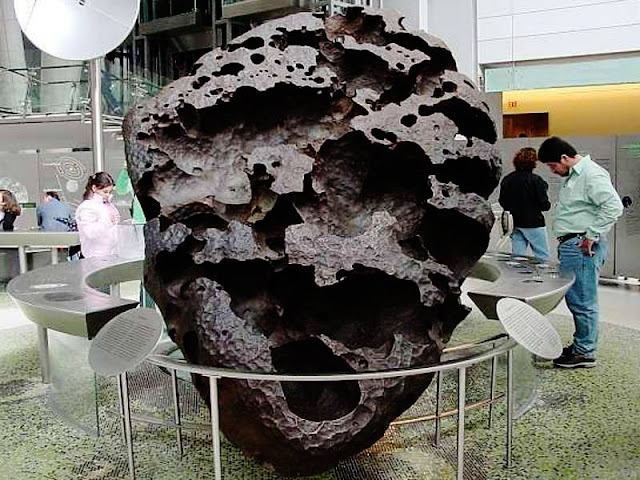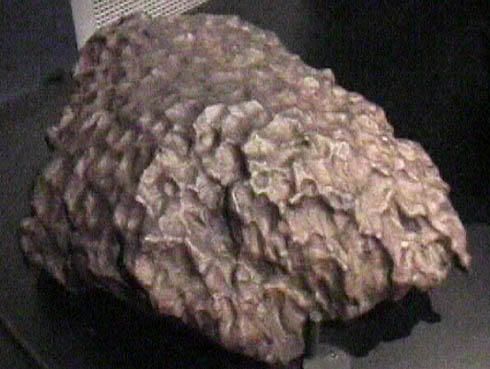Meteorites are traditionally classified as irons, stones, and stony-irons.
Casas Grandes 2,300 kg iron meteorite. Found carefully wrapped in linen and buried on a grave in an ancient temple, at an archaeological site in northern Mexico; Mogollon culture. Settlement began 1130 AD, abandoned approximately 1450 AD.

The “irons” are composed of nearly pure metallic nickel-iron. This makes it easy to classify them as extraterrestrial in origin because pure metallic iron almost never occurs naturally on the Earth – it is in the form of some oxide. Fraknoi, et al. comment ” if you ever come across a chunk of metallic iron, it is sure to be either man-made or a meteorite.” The stony meteorites are more common but harder to identify, often requiring isotopic analysis to be sure. The stony-irons, mixtures of metallic iron and stone, are much rarer.

The Casas Grandes meteorite, on display at the Smithsonian Museum of Natural History, has a dimension of perhaps 1.5 meters. It was found in Chihuahua, Mexico. The sliced section here shows it to be essentially solid metal in the interior.

A closer view makes it clear that this is solid metal! There are interesting lines and striations associated with the crystal formation.

The metal is so solid and so pure that it can be cut into slices! These sections are perhaps a centimeter and a half thick and some 70-80 cm across.
Large Australian iron meteoritesIndex
Solar System Illustration
Solar System Concepts
Reference
Fraknoi, Morrison & Wolff.
Ch 13 HyperPhysics********** AstrophysicsR NaveGo Back


This is one piece of a large iron meteorite collection which left 13 impact craters in Australia. It is on display in the Smithsonian Museum of Natural History. It is thought to be about 10,000 years old. This fragment is about a meter across.
Related Post
A shocking documentary proves that mermaids do exist
SHOCKING Revelation: Thuya, Mother of Queen Tiye, Was the Grandmother of Akhenaten and Tutankhamun—What Ancient Egyptian Secrets Did She Leave Behind?
Breaking News: Astonishing Discoveries at Karahan Tepe Confirm an Extraterrestrial Civilization is Hiding on Earth, and NO ONE Knows!
Breaking News: Researchers FINALLY Discover U.S. Navy Flight 19 After 75 Years Lost in the Bermuda Triangle!
NASA’s Secret Investigation: Uncovering the Astonishing Mystery of the UFO Crash on the Mountain!
Explosive UFO Docs LEAKED: Startling Proof That Aliens Ruled Ancient Egypt!